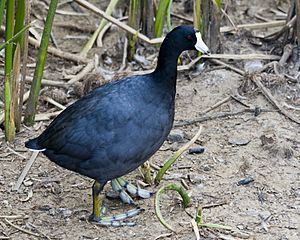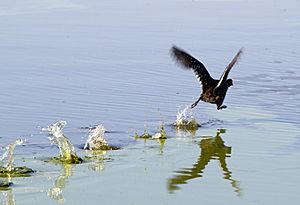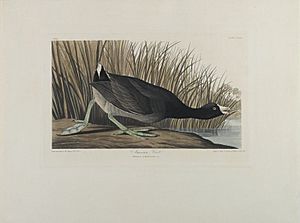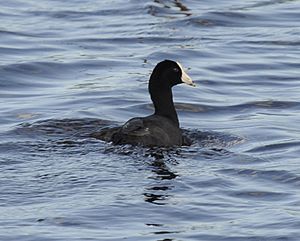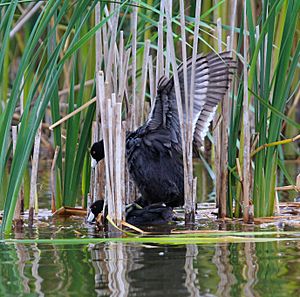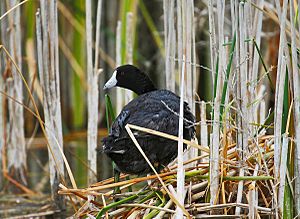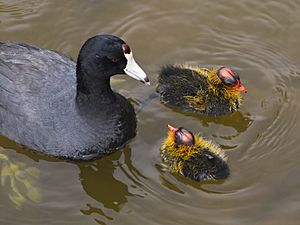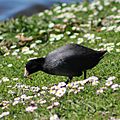American coot facts for kids
Quick facts for kids American coot |
|
|---|---|
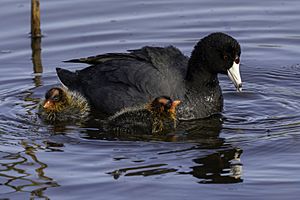 |
|
| American coot with chicks, Pescadero Marsh Natural Preserve, California | |
| Conservation status | |
| Scientific classification | |
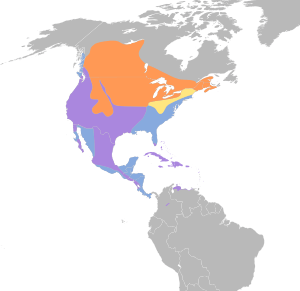 |
|
| Breeding range Winter-only range Year-round range | |
| Synonyms | |
and see text |
The American coot (Fulica americana), also known as a mud hen or pouldeau, is a bird from the bird family called Rallidae. Many people mistake coots for ducks. However, American coots are only distantly related to ducks. They belong to a different group of birds.
Unlike ducks, coots do not have fully webbed feet. Instead, they have broad, lobed scales on their toes. These scales fold back when the coot walks on land. This helps them move easily on both land and water. Coots live near water, often in wetlands and open water areas in North America. When many coots gather together, they are called "covers" or "rafts." The oldest known coot lived to be 22 years old!
American coots are migratory birds. This means they travel to different places during the year. They live in the Pacific and southwestern United States and Mexico all year round. In the summer, they move to more northeastern areas to breed. In winter, they can fly as far south as Panama. Coots usually build floating nests. They lay about 8 to 12 eggs at a time. Male and female coots look similar. However, males have a larger "ruff" (feathers on their head) during fights. American coots mainly eat algae and other water plants. They also eat small animals, like insects and fish, when they can find them.
The American coot is listed as "Least Concern" by the IUCN. This means they are not currently in danger of disappearing. Hunters usually do not hunt coots. This is because their meat is not as popular as duck meat.
Scientists have studied the breeding habits of American coots a lot. They found that mother coots prefer to feed their chicks with the brightest feathers. These bright feathers are called "chick ornaments." American coots also sometimes have other coots lay eggs in their nests. This is called "brood parasitism." Coots have learned ways to tell which chicks are their own and which are from other coots.
Contents
About the American Coot

The American coot was first described by Johann Friedrich Gmelin in 1789. It belongs to the Rallidae bird family. There are different types of American coots, sometimes called subspecies. These include Fulica americana alai, F. a. caribaea, and F. a. ardesiaca. Some people even think these might be separate species! There are 11 types of coots in the Fulica group found around the world.
The name Fulica comes from the Latin word for "coot." The word americana means "America."
What Does an American Coot Look Like?
The American coot is about 34 to 43 centimeters (13 to 17 inches) long. Its wingspan is about 58 to 71 centimeters (23 to 28 inches). Adult coots have a short, thick, white bill. They also have a white patch on their forehead called a frontal shield. This shield usually has a reddish-brown spot near the top, between their eyes. Males and females look alike, but females are usually smaller.
Young coots have olive-brown heads and gray bodies. They get their adult colors when they are about 4 months old.
Coot Sounds
American coots make many different sounds. Male and female coots have different calls for similar situations. For example, male coots make a puhlk sound when they are alarmed. Female coots make a poonk sound. When males are stressed, they might say puhk-cowah or pow-ur. Females call cooah when stressed.
Where Do Coots Live?
American coots live near water. They like lakes and ponds with reeds, open marshes, and slow-moving rivers. They prefer fresh water. However, they can live in saltwater areas during the winter.
American coots breed in marshes from southern Quebec to the Pacific coast of North America. They also breed as far south as northern South America. Birds from central North America fly south for winter. They go to the southern United States and southern British Columbia. Some coots stay all year in places where the water does not freeze. More and more coots are staying in northern areas year-round.
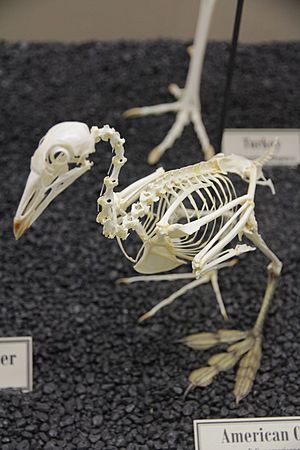
Coots fly south for winter from August to December. Males and non-breeding birds leave first. Females and young birds follow later. They fly back north to their breeding areas from late February to mid-May. Males and older birds usually go first. Some coots have even been seen as far north as Greenland and Iceland!
Caribbean Coots
Coots that live in the Caribbean and Antilles islands used to be thought of as a separate species. They were called the Caribbean coot (Fulica caribaea). These coots do not have the red spot on their forehead shield. However, in 2016, scientists found that some American coots also have fully white shields. This made it hard to tell them apart. Also, there was no sign that Caribbean and American coots avoided mating with each other. So, the American Ornithological Society decided that the Caribbean coot is just a regional type of the American coot.
Coot Behavior
American coots are very social birds. This is especially true in winter, when their groups can have thousands of birds. When swimming, coots make interesting shapes. They can form single lines, swim close together, or make wide arcs. They also take off from the water in a special order.
What Do Coots Eat?
American coots can dive underwater to find food. They also look for food and scraps on land. Their main food is water plants, especially algae. But they are omnivores, meaning they eat both plants and animals. They also eat insects, fish, and other small water animals. During breeding season, coots eat more water insects and snails. These foods are very important for young chicks.
How Coots Breed
Coot mating season is in May and June. Coots usually stay with the same partner for life. This is if they have a good place to live. Their breeding cycle has several steps. These include finding a partner, building a nest, mating, laying eggs, sitting on the eggs (incubation), and hatching.
American coots often have long courtship periods. This involves touching bills, bowing, and gentle pecking. Males usually start the bill-touching. As the pair gets closer, they only touch bills with each other. Once they are a strong pair, they look for a place to build a nest. The pair bond becomes permanent when they find a nesting spot.
Coot Nests
American coots are busy builders. They make several structures during one breeding season. There are three main types of structures: display platforms, egg nests, and brood nests.
- Display platforms are used for resting. They are left to fall apart after mating.
- Egg nests are usually about 30 centimeters (12 inches) wide. They have a ramp of 30 to 38 centimeters (12 to 15 inches). This ramp helps parents get in and out without damaging the nest. Coots often build many egg nests before choosing one for their eggs.
- Brood nests are new nests or old egg nests that have been made bigger after the eggs hatch.
Since coots build on water, their nests can fall apart easily. Egg and brood nests are like floating rafts. They need to be built up constantly to stay afloat. Female coots usually do most of the building work.
Laying Eggs
Female coots lay one egg each day until all the eggs are laid. Eggs are usually laid between sunset and midnight. Nests made earlier in the season usually have more eggs. They average about 9 eggs per nest. Later nests average about 6.4 eggs. Eggs laid earlier in the sequence are usually larger than eggs laid later. If some eggs are removed from a nest, a female coot might lay more eggs. However, if too many eggs are removed, she might leave the nest. Coots do not lay fewer eggs if extra eggs are added to their nest.
American coots will often build new nests if their first ones are destroyed. They can replace lost eggs within two days. Studies show that 68% of destroyed nests are replaced. These new nests usually have one or two fewer eggs. This might be because of the time of year or the quality of the habitat.
Younger female coots lay eggs later in the season. Their eggs are smaller than those of older females. Their chicks are also smaller. However, younger and older females lay about the same number of eggs.
Incubation and Hatching
Incubation is when the parents sit on the eggs to keep them warm. For American coots, incubation can start at different times. It might begin with the first egg or after all eggs are laid. Starting incubation before all eggs are laid is not common for birds. Once incubation starts, it continues without stopping. Both male and female coots share the job of incubating. But males do most of the work during the 21-day incubation period. If a nest is destroyed during incubation, females will start a new nest in about six days.
Chicks usually hatch in the same order that the eggs were laid. No matter how many eggs are laid, usually only eight chicks survive. Coots often leave some eggs behind because females lay more than eight eggs. The number of chicks that hatch limits how long parents will incubate. Once a certain number of chicks hatch, the remaining eggs are left. Scientists are still learning why some eggs are abandoned. It might be because there isn't enough food for all the chicks. Or, the remaining eggs might not feel or look stimulating enough to keep the parents incubating. If coots are forced to hatch more eggs than usual, those extra chicks often do not survive. This is because the parents cannot feed or care for them all.
Parental Influence
Hormones from the mother can pass into the egg. These hormones affect how chicks grow, behave, and interact with others. This is called a maternal effect. In American coots, there are different levels of hormones like androgens and testosterone. Eggs laid earlier in a nest have higher testosterone levels. Females who lay three nests of eggs put more hormones into their eggs than those who lay only one or two nests.
Brood Parasitism (Other Coots Laying Eggs)
The American coot sometimes has other coots lay eggs in their nests. This is called brood parasitism. It is a common way for some coots to have babies. In one study, scientists found that 40% of nests had eggs from other coots. And 13% of all eggs were laid by females in nests that were not their own. Coots do this to have more babies, especially if they have problems like not having their own territory or nest. Female coots might also lay eggs in other nests if their own nest is destroyed.
When a parasitic female lays her egg in another coot's nest, the host female might get two eggs in one day. Host females might notice these extra eggs because the pattern of laying changes from one egg per day. Parasitic females are often larger than the host females, but not always.
Unlike some other birds, American coots can recognize and reject parasitic chicks. Parents might peck them, drown them, or stop them from entering the nest. They learn to recognize their own chicks by remembering what the first chick that hatches looks like. Chicks that do not match this memory are seen as parasites and are rejected.
Recognizing parasitic chicks helps coots save energy and food. Coots are one of only three bird species that can do this. This is because in coots, the host's eggs usually hatch before the parasite's eggs. In other bird species, if the hatching order is not clear, there is a risk. Parents might accidentally think a parasite chick is their own and then reject their real chicks. For those birds, the risk of making a mistake is greater than the benefit of rejecting parasite chicks.
Chick Ornaments
Scientists first found evidence of parents choosing chicks with special, fancy features in American coots. Baby coots are black. They have bright orange tips on their feathers, especially on the front of their bodies. These are called "chick ornaments." These bright colors fade after about six days. These bright feathers make coot chicks easier for predators to spot. They also do not help the chicks stay warm. But parents still choose chicks with these bright feathers. These plumes are not needed for the chick to survive. However, chicks with brighter ornaments are more likely to be chosen as favorites by their parents. Scientists did an experiment where they clipped the bright plumes. They found that parents preferred chicks with the bright plumes over those without them.
Who Hunts Coots?
American coots are quite aggressive when protecting their eggs. Their nests are also well-hidden. This helps protect their eggs and young from most predators. American crows, black-billed magpies, and Forster's terns sometimes eat coot eggs. Mammals like red foxes, coyotes, skunks, and raccoons are less likely to attack coot nests. However, muskrats sometimes destroy nests to take over the area.
Outside of breeding season, young and adult coots can become prey more often. Predators include great horned owls, northern harriers, bald eagles, golden eagles, American alligators, bobcats, and large gulls. In some places, coots can make up more than 80% of a bald eagle's diet!
Coots in Culture
On the Louisiana coast, the Cajun word for coot is pouldeau. This comes from the French words poule d'eau, which means "water hen." Coots can be used for cooking. They are somewhat popular in Cajun cuisine, for example, in gumbos made by duck hunters.
The American coot is also the mascot for the Toledo Mud Hens Minor League Baseball team.
Conservation and Threats
The American coot is listed as "least concern" by the IUCN Red List. This means they are common and widespread. Sometimes, people even see them as a pest. Hunters rarely target them because their meat is not as popular as duck meat. However, some are hunted for sport, especially in the southeastern United States. Since coots live in wetlands, scientists use them to check for toxins and pollution in these areas.
Images for kids
See also
 In Spanish: Focha americana para niños
In Spanish: Focha americana para niños



